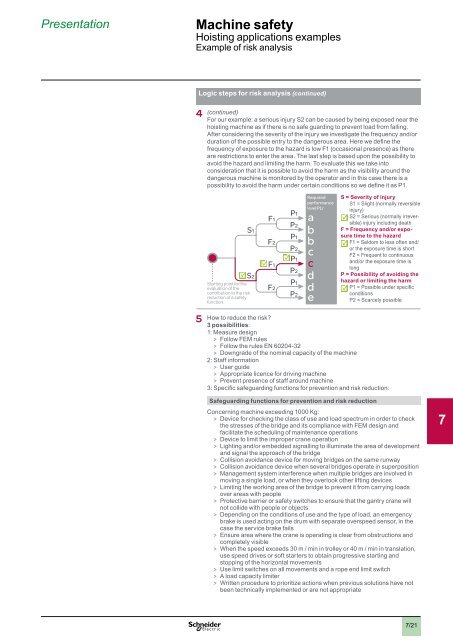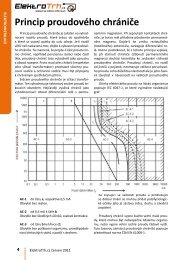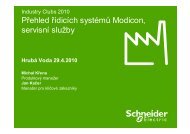2 - Schneider Electric CZ, s.r.o.
2 - Schneider Electric CZ, s.r.o.
2 - Schneider Electric CZ, s.r.o.
Create successful ePaper yourself
Turn your PDF publications into a flip-book with our unique Google optimized e-Paper software.
Presentation<br />
Machine safety<br />
Hoisting applications examples<br />
Example of risk analysis<br />
Logic steps for risk analysis (continued)<br />
(continued)<br />
For our example: a serious injury S2 can be caused by being exposed near the<br />
hoisting machine as if there is no safe guarding to prevent load from falling.<br />
After considering the severity of the injury we investigate the frequency and/or<br />
duration of the possible entry to the dangerous area. Here we define the<br />
frequency of exposure to the hazard is low F1 (occasional presence) as there<br />
are restrictions to enter the area. The last step is based upon the possibility to<br />
avoid the hazard and limiting the harm. To evaluate this we take into<br />
consideration that it is possible to avoid the harm as the visibility around the<br />
dangerous machine is monitored by the operator and in this case there is a<br />
possibility to avoid the harm under certain conditions so we define it as P1.<br />
Starting point for the<br />
evaluation of the<br />
contribution to the risk<br />
reduction of a safety<br />
function<br />
Required<br />
performance<br />
level PLr<br />
S = Severity of injury<br />
S1 = Slight (normally reversible<br />
injury)<br />
S2 = Serious (normally irreversible)<br />
injury including death<br />
F = Frequency and/or exposure<br />
time to the hazard<br />
F1 = Seldom to less often and/<br />
or the exposure time is short<br />
F2 = Frequent to continuous<br />
and/or the exposure time is<br />
long<br />
P = Possibility of avoiding the<br />
hazard or limiting the harm<br />
P1 = Possible under specific<br />
conditions<br />
P2 = Scarcely possible<br />
How to reduce the risk?<br />
3 possibilities:<br />
1: Measure design<br />
> > Follow FEM rules<br />
> > Follow the rules EN 60204-32<br />
> > Downgrade of the nominal capacity of the machine<br />
2: Staff information<br />
> > User guide<br />
> > Appropriate licence for driving machine<br />
> > Prevent presence of staff around machine<br />
3: Specific safeguarding functions for prevention and risk reduction:<br />
Safeguarding functions for prevention and risk reduction<br />
Concerning machine exceeding 1000 Kg:<br />
> > Device for checking the class of use and load spectrum in order to check<br />
the stresses of the bridge and its compliance with FEM design and<br />
facilitate the scheduling of maintenance operations<br />
> > Device to limit the improper crane operation<br />
> > Lighting and/or embedded signalling to illuminate the area of development<br />
and signal the approach of the bridge<br />
> > Collision avoidance device for moving bridges on the same runway<br />
> > Collision avoidance device when several bridges operate in superposition<br />
> > Management system interference when multiple bridges are involved in<br />
moving a single load, or when they overlook other lifting devices<br />
> > Limiting the working area of the bridge to prevent it from carrying loads<br />
over areas with people<br />
> > Protective barrier or safety switches to ensure that the gantry crane will<br />
not collide with people or objects<br />
> > Depending on the conditions of use and the type of load, an emergency<br />
brake is used acting on the drum with separate overspeed sensor, in the<br />
case the service brake fails<br />
> > Ensure area where the crane is operating is clear from obstructions and<br />
completely visible<br />
> > When the speed exceeds 30 m / min in trolley or 40 m / min in translation,<br />
use speed drives or soft starters to obtain progressive starting and<br />
stopping of the horizontal movements<br />
> > Use limit switches on all movements and a rope end limit switch<br />
> > A load capacity limiter<br />
> > Written procedure to prioritize actions when previous solutions have not<br />
been technically implemented or are not appropriate<br />
1<br />
2<br />
3<br />
4<br />
5<br />
6<br />
7<br />
8<br />
9<br />
10<br />
7/21
















